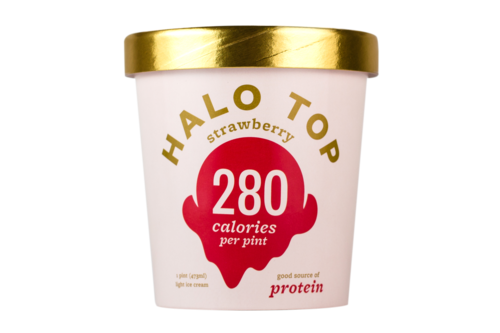Halo Top has quickly become the top selling ice cream brand in America since its launch in 2012. The secret behind this dessert manufacturer’s success is their product’s reduced-sugar and high-protein content. In order to appeal to the rapidly growing health-focused consumer market, Halo Top was able to formulate a guilt-free ice cream with the same texture, flavor and mouth feel of regular ice cream.
The Los Angeles-based frozen dessert manufacturer created their popular product by reducing sugar content and compensating the loss with a balance of two natural sweeteners. Erythritol is the main low-calorie sweetener used in Halo Top. It is naturally sourced from plants and comes in the form of a sugar alcohol. By blending the right amounts of erythritol and stevia, a natural sweetener sourced from the stevia plant, Halo Top is able to replace excess sugar while maintaining the flavor of their product. They also incorporate organic cane sugar into the mix in place of white sugar.
This mixture of ingredients allows Halo Top’s ice cream to have just 240 to 360 calories per pint. With pints of Haagen-Daz and Ben & Jerry’s ice cream coming in around 1,000 calories, it’s no surprise that Halo Top products have become more popular. In just the 12 weeks before Aug. 8, Halo Top had sales of $86.9 million, compared to $78.6 million in sales from Haagen-Dazs and $83.3 million in sales for Ben & Jerry’s.
Ravi Nana, Polyols Technical Service Manager for Minneapolis-based Cargill, Told Food Business News that ice cream makers can reduce 25 to 30 percent of their sugar content by using erythritol and stevia in their products.
“That’s enough to make a reduced-sugar label claim yet still deliver an ice cream treat that consumers will rave about,” he added.
Though there are other low-calorie, high protein ice creams on the market, many of them face the consequences of reducing sugar in their products. Sugar reduces the freezing point of frozen desserts, preventing the formation of ice crystals and resulting in a smooth texture. Other reduced sugar desserts do not have the same mouth fell, texture or sweetness of their original counterparts. Halo Top’s recipe may be the answer many food manufacturers are looking for.
Erythritol alone cannot make up the sweetness of sugar, so it needs to be combined with high-intensity sweeteners like stevia and monk fruit. Other natural sweetener options include inulin and chicory root extracts. Chicory root fibre is up to 60 percent sweeter than sugar, reducing the need to mix it with other natural sweeteners. Halo Top’s sweetener combination is so far, the most successful.
Although Halo Top has demonstrated an impressive sales portfolio, they have conquered only one frozen dessert category, not including sherbet or gelato. With the entire ice cream category valued at $6.6 billion, with 68 percent of consumers willing to pay more for food and drinks that do not contain undesirable ingredients, Halo Top’s achievement is still very substantial.
“It didn’t happen just once; it’s sustained. It’s a remarkable story,” said John Crawford, vice president of the western dairy region for Chicago-based IRI. “It’s crazy that someone can just come into an established industry and do this.”
Halo Top has the most interesting success story to come out of the low-calorie ice cream industry. Many companies have struggled to break into the low-calorie dessert field due to the consumer belief that reduced sugar can negatively affect the taste of products. Halo Top’s sweetener recipe might be able to help other companies find a way around the negative stigma that reduced-sugar products have.












Join or login to leave a comment
JOIN LOGIN